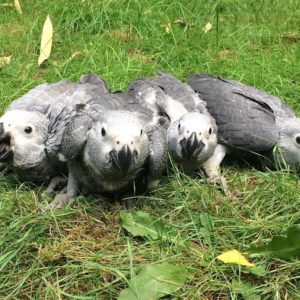Care & Feeding
 A cage provides parrots with a retreat that they know is their territory in your home. It also assists in meeting your parrot’s needs, such as controlling lighting; parrots ideally need 12 hours of daylight and 12 hours of darkness.
A cage provides parrots with a retreat that they know is their territory in your home. It also assists in meeting your parrot’s needs, such as controlling lighting; parrots ideally need 12 hours of daylight and 12 hours of darkness.
The size of the cage varies by species. All parrots need a cage that allows them to spread their wings freely in the fully accessorized cage. Species with long tails need cages that are tall enough to accommodate the tail length. Did you catch the phrase fully accessorized? You need to furnish your feathered friend’s “bird cave.” Research the best cage material for your parrot’s species.
The Merck Veterinary Manual offers the following general guidelines for size: 20 x 20 x 30 inches for budgies, cockatiels, lovebirds, or parrotlets; 36 x 24 x 48 inches for conures, Poicephalus, caiques, miniature macaws; 40 x 30 x 60 inches for African grey parrots, Amazon parrots, and small cockatoos; 48 x 36 x 66 inches for macaws and large cockatoos. Bar spacing ranges from 0.5 inches to 1.5 inches for the smallest to largest species. Keep in mind that these suggested sizes are minimum for a single bird, and a bigger cage is always better! If you choose to keep multiple parrots, be prepared to offer a cage for each. Sharing a cage usually only works for the same species, and even that isn’t a guarantee that birds will get along. Never house birds together that show any aggression toward each other. And be absolutely certain you know the sex of your birds before letting any share a cage.
 Keeping the cage clean is critical to your parrot’s health. Get into a regular routine of daily tasks like changing out paper and cleaning dishes and water bottles and weekly and monthly tasks like toy rotation and deep cleaning.
Keeping the cage clean is critical to your parrot’s health. Get into a regular routine of daily tasks like changing out paper and cleaning dishes and water bottles and weekly and monthly tasks like toy rotation and deep cleaning.
Parrots groom themselves, but they need some help from you. Provide the opportunities for bathing, be it hanging out in the bathroom while you shower or misting water above their head. Turn on the shower and see if your feathered friend wants to check it out or splash in the sink with the faucet on. Besides bathing, other regular grooming your parrot might need includes beak trims, wing trims, and nail trims. Consult your avian veterinarian for recommendations on these for your parrot.
Eating like a bird means different things to different species. Parrots are mostly known for eating seeds, nuts, fruit, and vegetables, but most are omnivores rather than herbivores. And some, namely the lory, mainly eat nectar. Some species are more prone to vitamin deficiencies and some are prone to obesity. That’s why a balanced diet is so important. Nutri-Berries deliver a balanced diet that’s also tasty and interesting to promote nutritious foraging. For variety, other healthy, balanced Lafeber foods include Avi-Cakes, Fruit Delight Avi-Cakes, Gourmet Nutri-Berries, Pellet Berries, and Senior Bird Nutri-Berries. For a treat, try Popcorn Nutri-Berries.
In addition to a balanced diet, parrots enjoy eating some fresh foods daily. These are snacks, so keep portions balanced for the size of your bird. Berries, bananas, leafy greens, and squash are some of the healthy foods safe to feed parrots. Some foods you might consider healthy are actually bad food for birds, so do your homework and consult your avian veterinarian about any foods you doubt the safety of for your bird.
Where to eat might be as important to some birds as what to eat. Cockatiels, for example, are ground foragers and would likely prefer their food served on the floor of their cage. Find out the preferred eating style of your parrot’s species.

